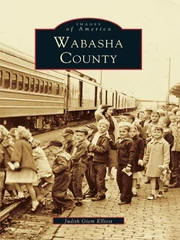


 |
 |
 |
|
|
Navigation LakesnWoods.com
© 2004-2025 DCMA, Defamation, Copyright and Trademark Infingement Policy
Minnesota State Bird Women's Light T-Shirt
It's Time
to Fish! Clock
|
|
|
|
|
|
 Wabasha County Courthouse, Wabasha Minnesota, 1896 Courtesy John R. Borchert Map Library - click image to enlarge |
|
|
|
|
|
|
|
|
|
|
|
|
|
|
 |
Wabasha County (Images of America) |
| Wabasha County captures the spirit of a region and its people through rare historic photographs, many of which are previously unpublished. A truly multicultural community, Wabasha County has been home to residents of Canadian, French, English, Irish, Native American, and German origin. The earliest known pioneers, Augustine Rocque and his family, became the first white people to occupy a year-round residence in Minnesota in 1826. Within these pages, discover the people and events that have shaped Wabasha County’s history over the past 170 years. Wabasha County was named after the great chief Wabashaw II. Many aspects of Wabasha’s heritage are featured here, including the Mdewakanton Band of the Dakotas, riverboats of the Mississippi, pioneers and their descendants, and buildings throughout the area. Author Judith Giem Elliott has produced a volume that truly reflects the value Wabasha County’s residents place upon their rich and colorful history. | |
| Buy This Book Now! |
|
|
|
|
|
|
 |
Steam Railroads of Northern Iowa and Southern Minnesota |
| Steam railroading became an integral part of the communities in northern Iowa and southern Minnesota in the late 1800s. The railroad provided hundreds of jobs and the ability to transport both goods and passengers across the Midwest. The Chicago & North Western Railway, the Chicago Great Western Railroad, the Minneapolis & St. Louis Railway, the Chicago, Rock Island, & Pacific Railroad, and the Chicago, Milwaukee, St. Paul & Pacific Railroad (called the Milwaukee Road by employees) served five principal gateways, which included Chicago, Illinois; Minneapolis-St. Paul, Minnesota; Omaha, Nebraska; and Kansas City and St. Louis, Missouri. Operating steam engines required tremendous manpower, and by the 1920s, some steam passenger trains were replaced by more efficient motor cars, fueled by oil-powered engines. Steam engines could no longer compete with the reduced operating costs, smaller crew requirements, and time savings provided by diesel, which ultimately led to the fall of steam in 1955. | |
| Buy This Book Now! |
|
|
|
|
|
|
|
|
|
|
|
|
|
|
|
|
|
|
|
|
|
|
|
|
|
|
|
|
|
|
|
|
|
|
|
|
|
|
|
|
|
|
|
|
|
|
|
|
|
|
|
|
|
|
|
|
|
|
|
|
|
|
|
|
|
|
|
|
|
|
|
|
|
|
|
|
|
|
|
|
|
|
|
|
|
|
|
|
|
|
© 2004-2025 LakesnWoods LLC All Rights Reserved |
|
|
| ||